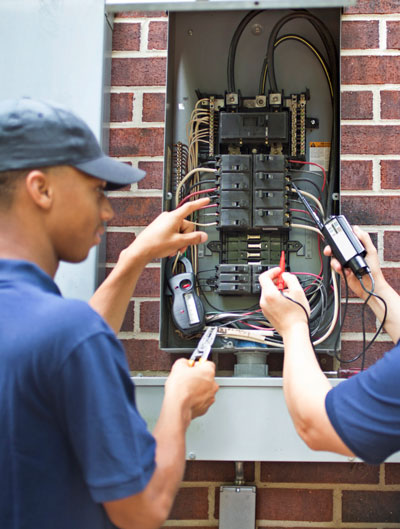Your Home’s Electrical Panel: What You Should Know
“I think we blew a breaker!” Chances are you’ve heard that a time or two in your lifetime. Of course, that means a trip to the electrical panel to flip the breaker back to the “On” position. Resetting a breaker is pretty simple, but there is a lot of safety protection woven into that process, and a reason why the breaker tripped. Today we’ll explore this a little further and shed some light on why the electrical panel is one of the most important safety features in your home.
Simply put, your electrical panel is the box that accepts electricity from the local utility company and distributes it throughout your home. Most circuits in the panel provide 120 volt electricity for applications like standard electrical outlets and lighting, while a limited number of higher capacity circuits supply 240 volt electrical power for appliances like electric ranges, air conditioners and clothes dryers.
For most of us, the delivery of electricity is a little like magic, with maybe a little fear factor thrown in. A tad of respect isn’t a bad approach, since electricity can be dangerous, but when the proper components are used and the work is performed and monitored by professional electricians, your safety comfort level can be quite high!
 So let’s take a closer look at this important cornerstone of our homes. We will also review a relatively recent advancement that offers safety protection not available or not commonly applied in homes constructed as recently as 10 or 20 years ago.
So let’s take a closer look at this important cornerstone of our homes. We will also review a relatively recent advancement that offers safety protection not available or not commonly applied in homes constructed as recently as 10 or 20 years ago.
Let There Be Light!
Following the development of the light bulb and electrical fuses in the late 1800s, the first electrical service panels came into existence in the early 1900s. Very rudimentary compared to what is installed today, these early electrical panels were limited in the number of circuits they provided, and initially offered only 120 volt power. In the 1950s, 240 volt service became available, but most electrical systems were still primitive by today’s standards, and replaceable fuses were the norm.
In the mid-1960s, the first modern style breaker switches were invented and home electrical supply began to resemble our modern systems. As this technology developed, there were an assortment of electrical panel designs in common usage. Not surprisingly, not all of them stood the test of time. Most of them functioned acceptably, but under certain conditions, they offered less protection than more modern devices. Today, many of these ‘not ready for prime time’ panels remain in service.
And Now?
In the decades following the introduction of the modern circuit breaker, multiple advancements in design have launched safety and effectiveness to new heights.
A circuit breaker is a resettable switch inside your service panel that protects the circuit from damage due to excess electrical current. The breaker is designed to cut power flow when an at-risk situation is detected, often caused by excessive demand on the circuit or a ‘short’ in the wiring or an appliance.
As opposed to their predecessor, replaceable fuses, the breaker switch can be reset when a breaker ‘trips.’ Resetting the breaker will typically suffice when the cause was temporary. But when a breaker continues to trip, it should not be ignored. It’s time to find the cause, and this will typically mean contacting a professional licensed electrician.
Beginning in 1999, and advanced further in the past 10 years, AFCI breakers are now required by code in most homes built in the U.S. In short, AFCI breakers provide the highest level of protection against electrical fires. We recommend installation of AFCI breakers in all homes for optimal safety protection, and older homes can be upgraded to include this protection.
The design of the electrical panel itself has also become more consistent. In the 1960s and 1970s, there were many approaches to how breakers were attached and laid out in the panel. Some of those designs were not as safe as others. Today, due to better engineering and more stringent building codes, modern electrical panels operate with a high degree of safety.
Is My Home’s Electrical System OK?
Like any component in your home, your electrical system will deteriorate over time and may not include all of the most current safety features and devices. Generalizing on the ‘typical lifespan’ for an electrical panel or wiring system is difficult. The quality of the original components, how well it was installed, and the conditions to which it has been exposed over the years are all relevant variables. That said, like most components in your home, your electrical system is not immune to deterioration. It can experience corrosion and loosening of internal wiring connections as part of the natural aging process, thus inspection and maintenance of your electrical system should not be ignored.
An experienced electrician can test your breakers and determine if they still respond correctly to unsafe conditions, identify if the panel is showing unusual signs of wear, and discuss with you the quality and safety features of the existing components. This would include identifying whether your system includes AFCI breakers, which provides the highest degree of safety.
Have Your System Inspected Regularly
Few among us are savvy enough to perform a professional inspection of our electrical panels and circuit breakers, or properly test the breakers and check the voltage being delivered to our homes. A professional electrician is the best person to make sure electricity is flowing safely in your home, indoors as well as outside.
In the Denver and Boulder, Colorado area, Save Home Heat Company has licensed electricians prepared to inspect your home electrical system for safety. Contact us today to schedule an annual safety inspection, or to help you with any of your lighting or electrical needs.




